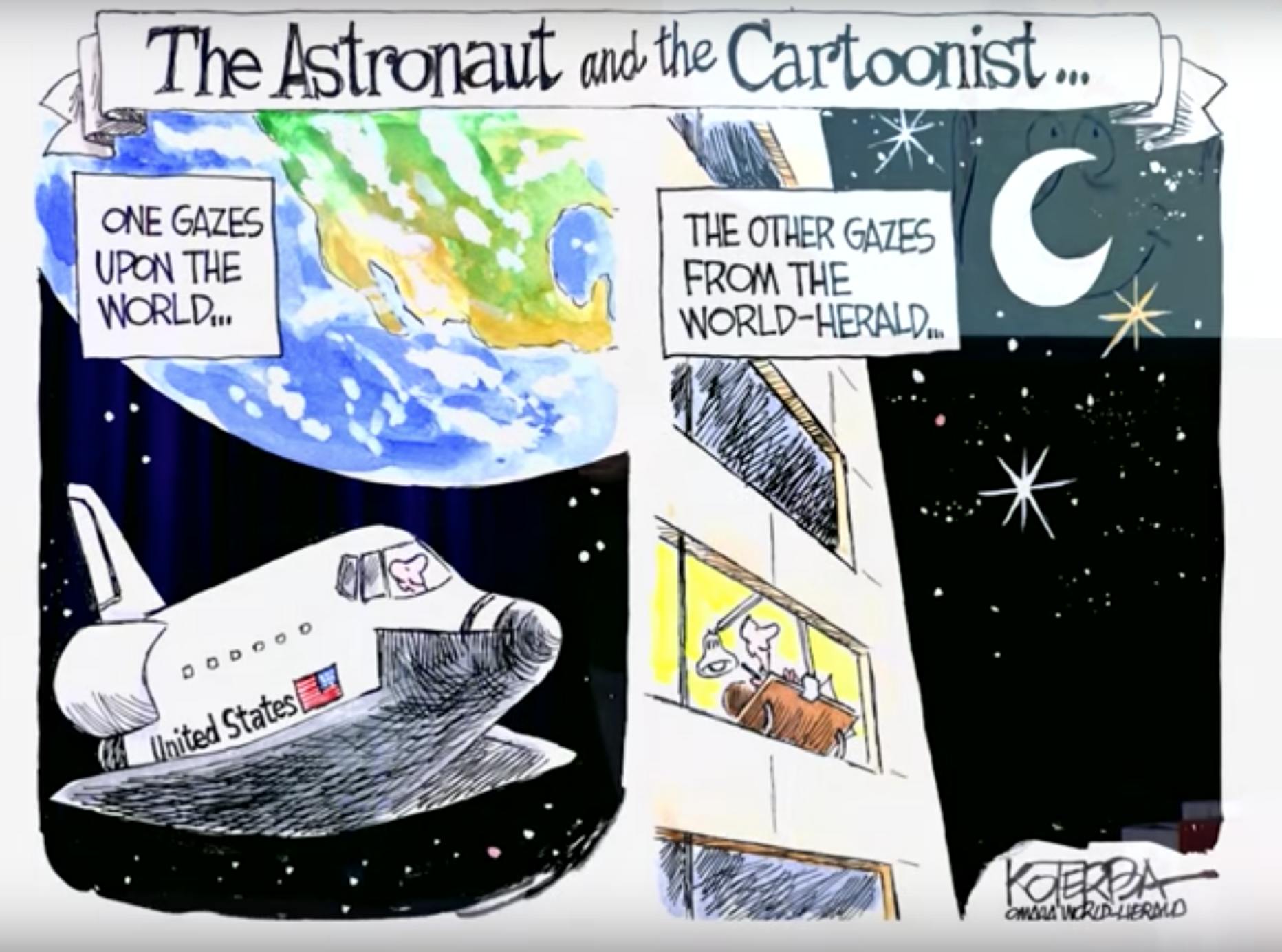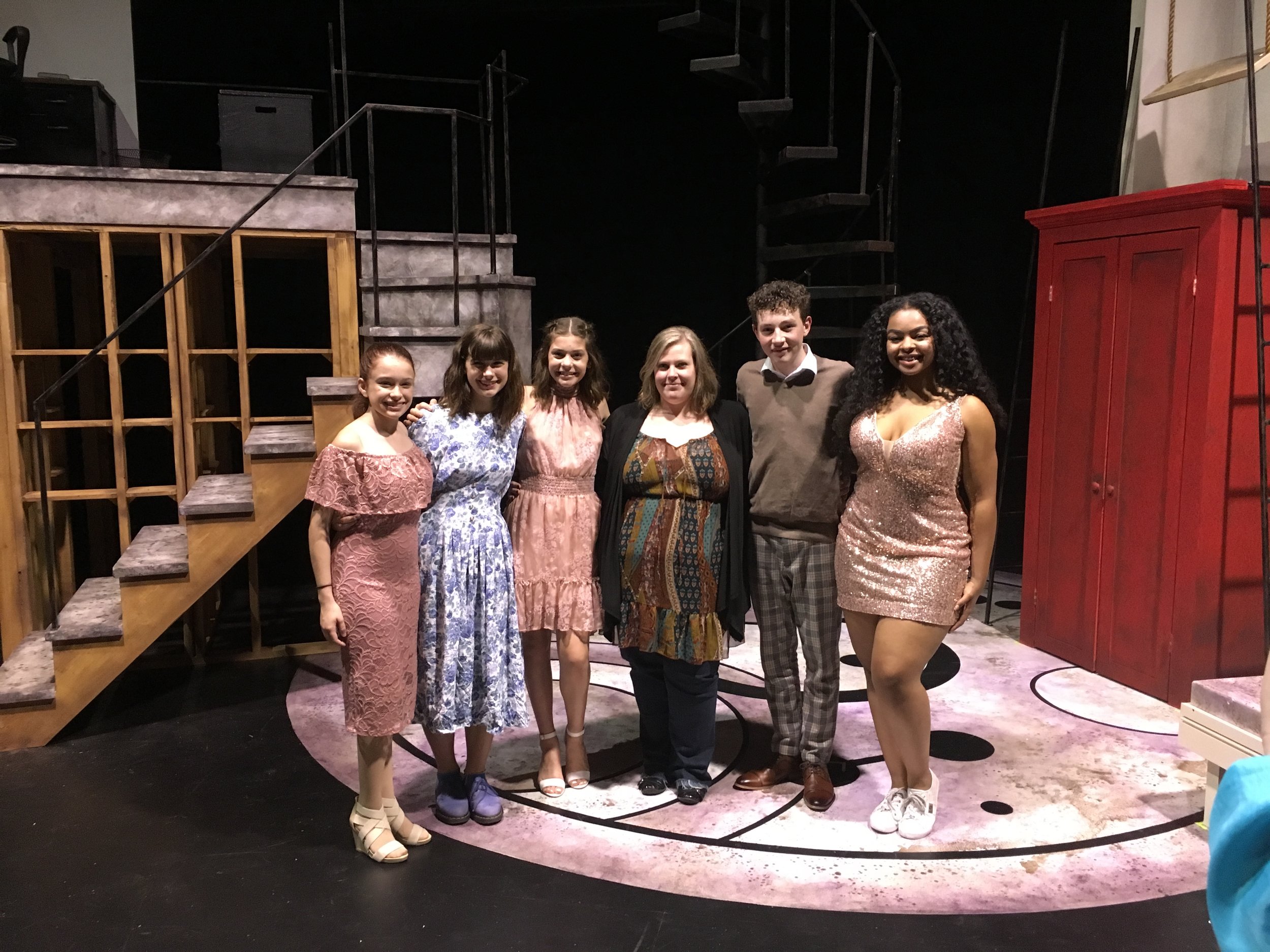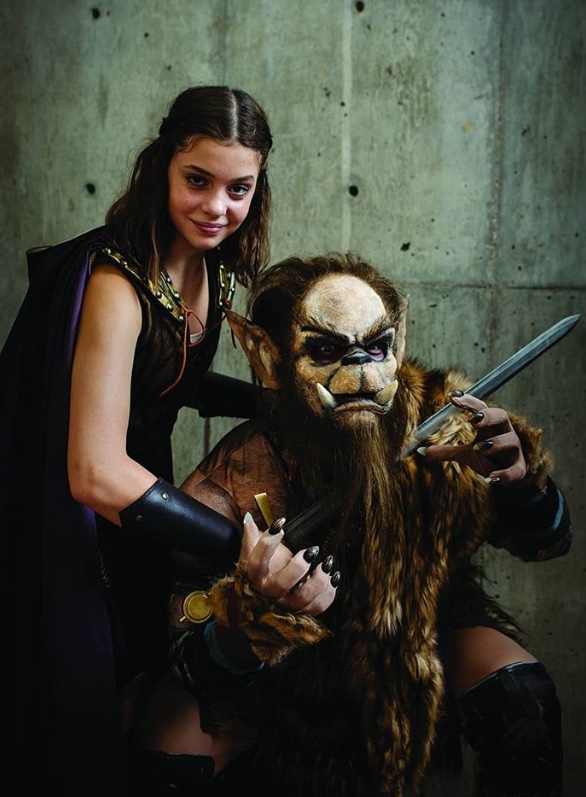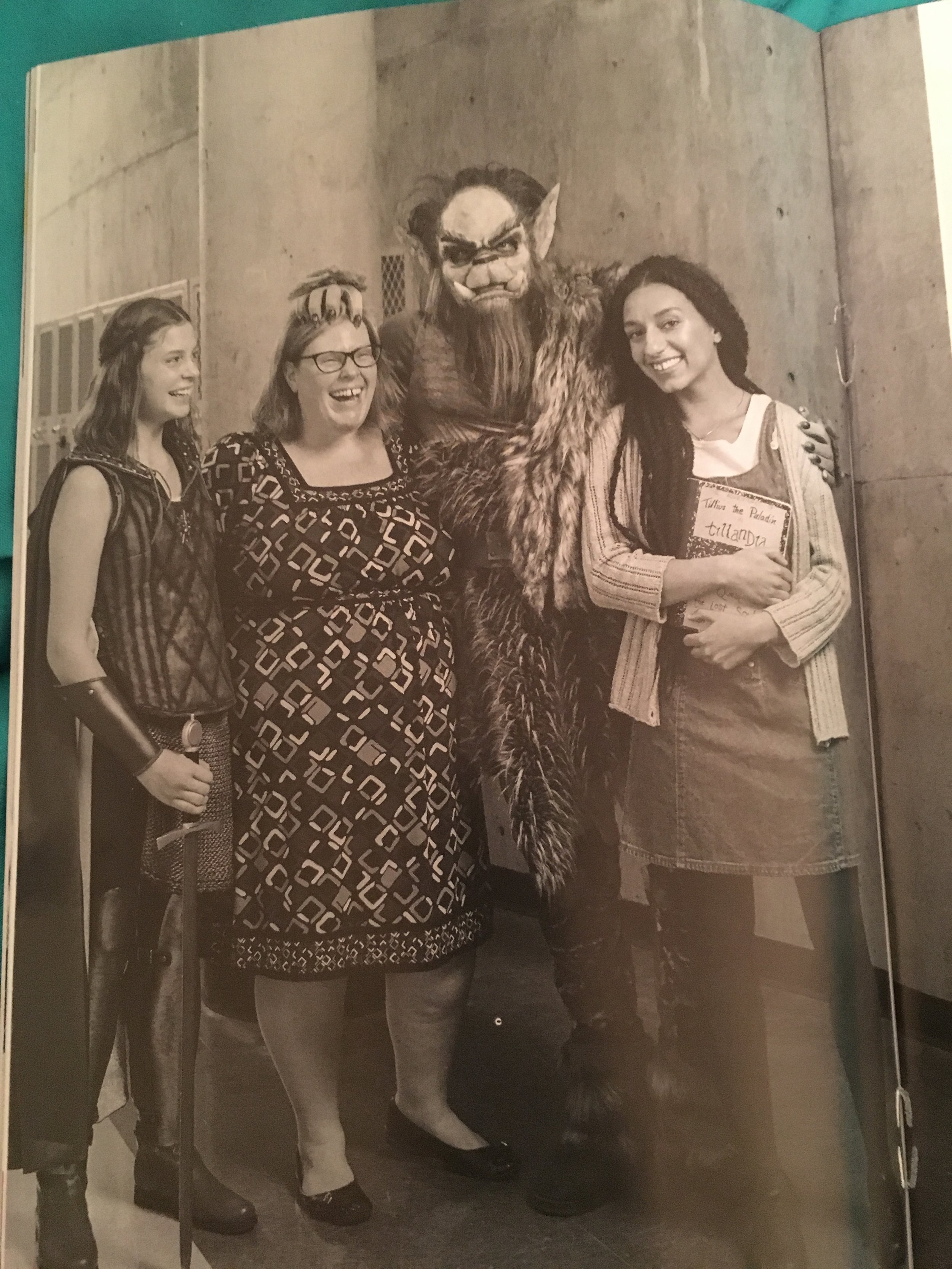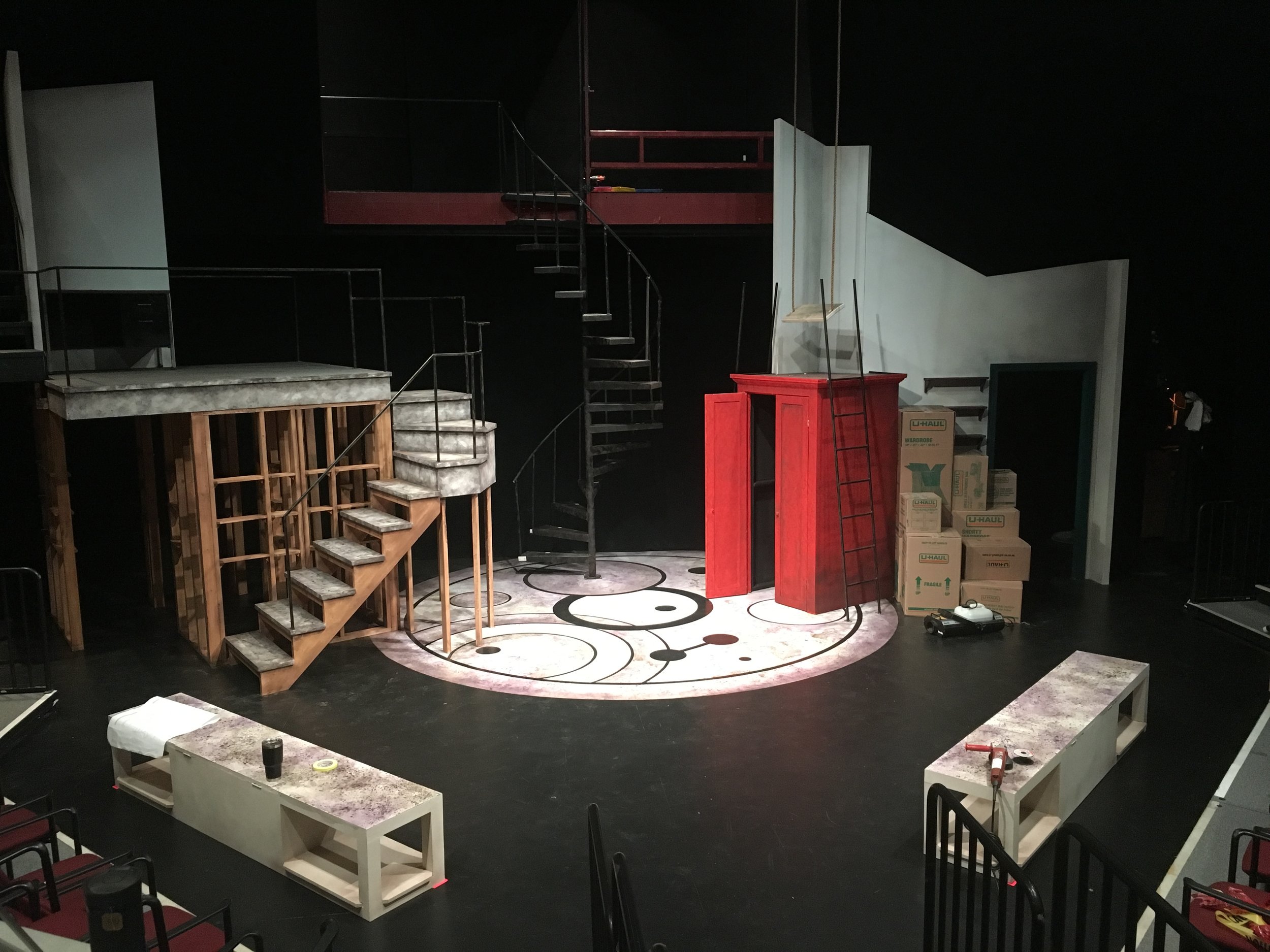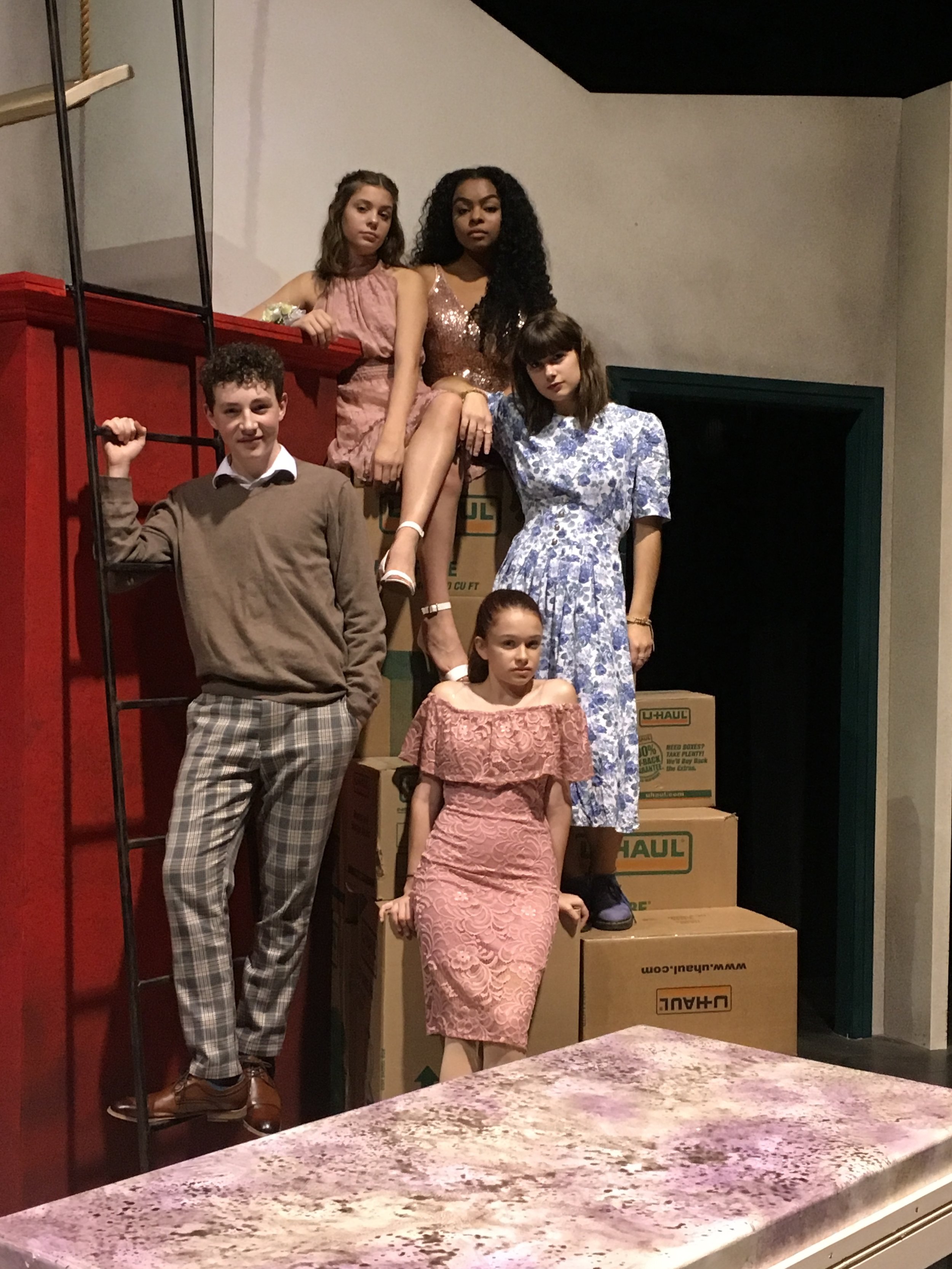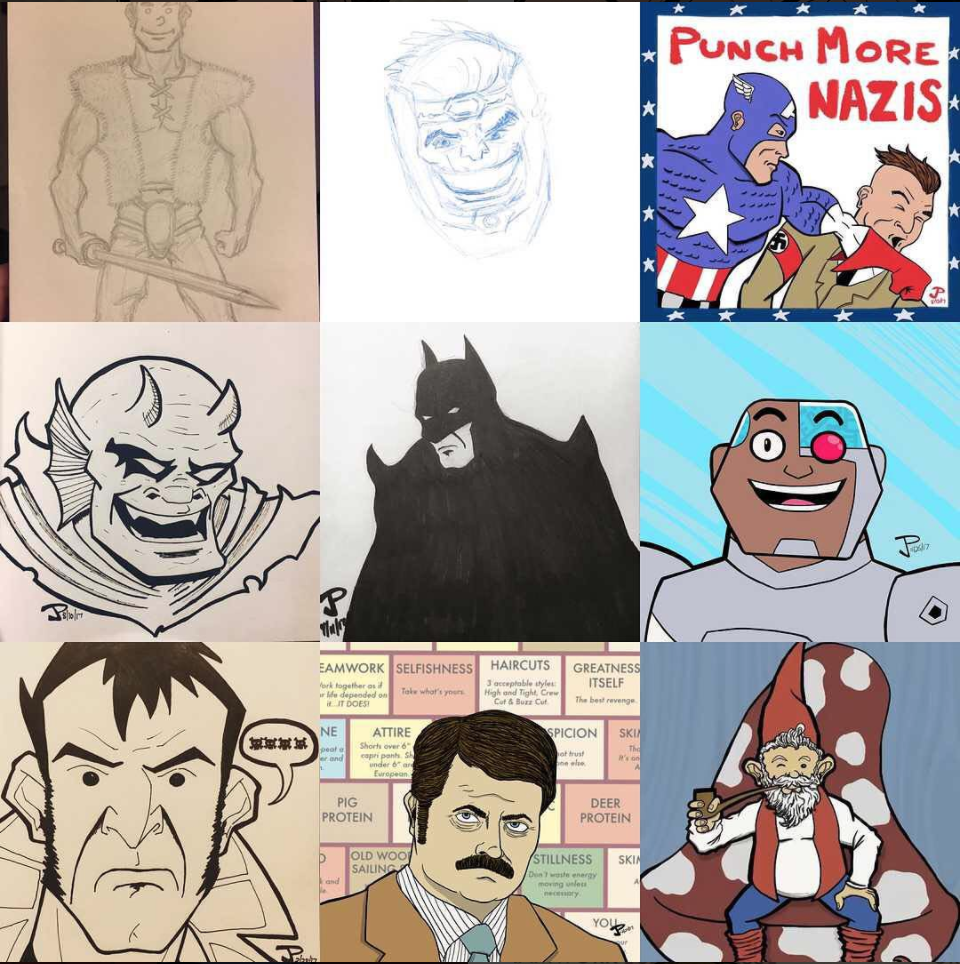JEFF KOTERBA is a cartoonist, writer, musician, and creativity advocate. He was born in Omaha, Nebraska, and during the summer before his senior year of high school, he was struck by lightning. Instead of taking him to the hospital, his dad gave him a shot of Jack Daniels.
You have always known you wanted to be a cartoonist. What was it about cartoons that you were drawn to?
For me, growing up in a chaotic household filled with broken TVs and junk, and considering all the noise from those TVs and family arguments, a blank sheet of paper represented a clean start, an escape. I actually dreamed of living on the ceiling—talk about a space for a mural!—but alas, I couldn’t overcome gravity.
Do you have any formal training or are your self taught?
It’s a mix. All along I had teachers encouraging me. I studied art pretty seriously in high school and college, although I have yet to finish my degree. But I’m also self-taught. When I was starting I sought out mentors, always asking for advice. I also lost a lot of sleep staying up practicing, just trying to get better.
It also bugs me a bit when people on Instagram say they are “self-taught” artists. Even if you have a formal education, I would certainly hope they are also self-taught but by saying that in an Instagram profile seems to diminish the person’s own work.
Where does your inspiration come from?
Everywhere and anywhere. It can be from keeping up with the news, but also from overhearing a conversation at a coffee shop. Sometimes I work backwards, like I might be enjoying an apple and days later I’ll think, gosh, is there a way for me to work an apple into a cartoon?
Who are the cartoonists you look up to?
I had many cartooning heroes when starting out, people whose work I would study, trying to figure out how they did what they did and those were Jim Borgman, Pat Oliphant, and Jeff MacNelly. These days, hands down, it’s Steve Sack in Minneapolis who draws on an iPad and his stuff is gorgeous. Certainly, I gain a lot from other cartoonists, too, but to be honest, I really don’t go out of the way to look at other work anymore. It’s more of an incidental thing now like if I’m at a cartooning salon like the ones I attend each year in France.
I would love to think I’ve been inspired by cartoonists from outside the U.S. but really, I get more from just talking with other cartoonists and from reading great books and watching great films.
You are a cartoonist, a musician, and a writer. Why is it important to have other creative outlets? How do they affect each other?
For me, because I have Tourette Syndrome, it’s a way to keep myself occupied, lest I sit around and obsess and twitch (laughs). But really, I do all those things because I must. There is a lot of suffering that goes along with creating anything, from making oneself vulnerable and I know no other way. They are all connected like I might be stuck on a cartoon idea so I’ll pick up the guitar and play a funky jazz chord and voila! A cartoon idea will come to me.
How has technology changed your art?
Working in color was a big one. There was a time when I only appeared in black and white and in print. Color and being able to use technology to make my work look a bit crisper is a good thing but I still draw with pens and brushes and ink, I love the tactile experience.
You have accomplished so much in your life creatively. Do you feel like there is more to do? Do you worry you wouldn’t have enough time to do it all?
There will never be enough time and I feel as if I am just getting started. I’m really trying to focus more on book projects—I have a couple of novels in the works and a graphic memoir. Anything worth doing takes huge amounts of time so I try to choose wisely by getting less sleep and working more (laughs). I also don’t waste time by passing it playing board games or engaging in small talk, I have zero interest in that, UNLESS those activities deepen my relationships and friendships then it’s worthwhile.
You had a close encounter with a UFO and your work has literally flown to space. Please talk about that.
The graphic memoir I’m working on has to do with the UFO—so not really ready to talk about that. Let’s just say that I’m a believer.
Regarding my space cartoons, I had one day received an email from the International Space Station. I’d drawn a cartoon about Nebraska-born astronaut, Clay Anderson, who at that moment, was flying 200 miles above me. Someone had managed to beam the cartoon to the space station and he emailed to thank me. We became friends and a few years later, when he returned to space, he asked me to come to his launch but only if I would draw a couple of cartoons he could take on board. How could I say no?
How, in your opinion, can cartoons contribute to great freedom?
Cartoons are probably the clearest and obvious example of what freedom of speech looks like. Even when I don’t agree with a particular cartoon, I respect the cartoonist’s right to their opinion. Good cartoons can be part of a big conversation. I might not change anyone’s mind but I just love being part of the conversation.
What do you like and dislike about doing editorial cartoons?
After I have the idea and the idea is the hard part, I enjoy losing myself in the actual drawing. When I’m inking, though, I can listen to music or French language lessons (laughs).
What I hate most is the awful stuff people say on social media about me. Never gets easier.
Despite your own political beliefs how important is to stay unbiased in your editorial cartoons?
Some cartoonists are so stuck to one extreme or the other their work becomes predictable and boring. I mean, I admire that they stick to their convictions, but for me, the truth is often not just over here or over there but it might be in the middle or a little here and there and a bit more from way over there. So I try to look at each issue with clarity and not with hatred that has permeated so much of the current political climate. But, of course, I can’t help but see the world through my own lens. Still, I strive to seek the Truth, capital-T.
Do you think editorial cartoons will look any different in the future than they do now?
Scientists are working around the clock to create a little pill that, when swallowed, puts you in the middle of a 3D cartoon. I really have no idea. Aside from the occasional animated editorial cartoon, the form really hasn’t changed much since Ben Franklin drew one of the first political cartoons with his “join or die” segmented snake drawing.
Do you have any new exciting projects in the works?
Besides, the books mentioned earlier? An animated short film based on a short story The New Yorker loved years ago but didn’t publish. It’s another project that is so time-consuming and I’m only writing the thing and doing the music. Not the actual animation. The animator lives in Omaha but is from Scotland by way of Australia who worked on Shrek and Lord of the Rings.
You were born and raised in Omaha, Nebraska please talk about what is it about Omaha that made you stay. How supportive has the community been with your art?
Well, I did live in Austria for two years, all while working for the World-Herald which gave me an interesting perspective. Otherwise, Omaha has advantages for creatives.
When my band played several shows in New York several years ago, it took nearly all day just to drive the van into town, unload at the club even though there was no official place to unload, find a parking spot—in one case nearly a mile away - It was a nightmare. Love that city but if I lived there I could only do one thing, maybe two. In Omaha, I can get around pretty easily and find time to write, draw, play music, and also get to the gym.
What sorta of perspective did you gain while living in Austria? Was it a personal one? An artistic one? A global one? And how did that perspective change your outlook?
Having been born in Omaha, and having lived there my whole life, it was interesting to DRAW about Omaha from the Alps rather than drawing about my surroundings. I was drawing about that place back there, in the U.S. I can’t say for sure that it changed my work in any dramatic or obvious way, but it felt I had some distance, room to breathe and that allowed the perspective to comment on things with that distance. Whereas, when living in the U.S. and commenting on things happening in Europe, well, that also feels like events that are happening way over there, stuff that doesn’t impact me directly.
Furthermore, living in Europe and commenting on European issues felt more immediate, more personal. Although I still had to be careful not to make my work too “inside.” Reminding myself that I was still drawing for a primarily-U.S. market. This, too: Seeing how people in Austria live—with their 4 1/2 day work weeks, and how coffee shops are places for conversation and reading, and not for sitting on your phone or laptop … and how sometimes in the U.S. we are too focused on making money or finding success or whatever.
Since joining the Omaha World-Herald in 1989, he has been a finalist for Editorial Cartoonist of the Year from the National Cartoonists Society—2002—and has twice placed second in the National Headliner Awards—2000 and 2012. He has also won first place for editorial cartooning in the Great Plains Journalism Awards five times, most recently in 2017. His cartoons are distributed through Cagle Cartoons to 850 newspapers around the globe and have appeared in such publications as The New York Times, the Washington Post, San Diego Union-Tribune, Dallas Morning News and USA Today. In 2010, two of Koterba’s cartoons flew aboard space shuttle Discovery. In 2017, he gave his second TEDx talk where he discusses Tourette’s Syndrome, vulnerability, and cartooning. His work has been included in multiple exhibits around the U.S. and in Europe, including alongside Picasso and Banksy, and in the Austrian embassy in Paris. His memoir, Inklings (Houghton Mifflin Harcourt) traces Koterba’s path on his journey to become a cartoonist, and more so, to rediscover the love of his family that was there from the start. Inklings was named a Chicago Tribune Favorite Nonfiction book of 2009. Entertainment Weekly called Inklings “…a powerful and moving portrait of an artist.” In 2019 he was named a finalist for a novel in the Tucson Festival of Books, and a semi-finalist for a second novel. He is the lead singer, guitarist, and songwriter for the Prairie Cats, a swing and jump-blues band he formed in 1998. The Prairie Cats have performed at the South by Southwest Music Festival, Windows on the World at the World Trade Center, and at the Derby Lounge in Hollywood. And in case there was any question, he now avoids thunderstorm whenever possible.
Jeff’s website here and keep up with Jeff via Instagram here









